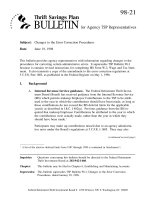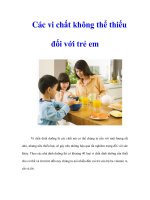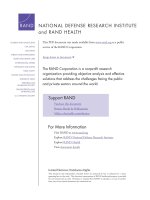Tài liệu A thesis submitted to The University of Birmingham for the degree of Clinical Psychology Doctorate docx
Bạn đang xem bản rút gọn của tài liệu. Xem và tải ngay bản đầy đủ của tài liệu tại đây (1.86 MB, 171 trang )
CHILDREN, YOUNG PEOPLE AND COELIAC DISEASE
VOLUME I: RESEARCH COMPONENT
BY
ELENI THEODOSI
A thesis submitted to
The University of Birmingham
for the degree of
Clinical Psychology Doctorate
School of Psychology
College of Life and Environmental Sciences
University of Birmingham
June 2009
University of Birmingham Research Archive
e-theses repository
This unpublished thesis/dissertation is copyright of the author and/or third
parties. The intellectual property rights of the author or third parties in respect
of this work are as defined by The Copyright Designs and Patents Act 1988 or
as modified by any successor legislation.
Any use made of information contained in this thesis/dissertation must be in
accordance with that legislation and must be properly acknowledged. Further
distribution or reproduction in any format is prohibited without the permission
of the copyright holder.
Children, young people and Coeliac Disease
Overview
Volume I
Volume I comprises a review of the literature about children and young people with
Coeliac Disease, a common autoimmune disease characterised by an immune
response to the protein gluten, found in wheat, barley and rye. It also comprises a
qualitative research paper detailing interviews with young people that aimed to tap
their lived experiences of the disease. The final part of Volume I comprise a public
domain briefing paper summarising both the literature review and research paper.
The literature review considers the evidence for problems with adherence to
treatment (a lifelong diet free from gluten) for young people with Coeliac Disease as
well as psychological effects of having the disease in childhood. Studies of parental
views were also included. The results suggested that there is some element of
psychological distress associated with having CD in childhood, and that adherence
to the treatment appears to be influenced by age and gender. Studies of parents’
views about their child’s Coeliac Disease suggested that parents’ belief in their ability
to manage the disease is important to how young children adhere to treatment.
The research project describes how 5 children and young people were recruited and
interviewed about their experiences of living with Coeliac Disease. The resulting data
were analysed using Interpretative Phenomenological Analysis and two themes were
subsequently identified. These themes related to identity as a young person with
Coeliac Disease and to perceptions about food.
Children, young people and Coeliac Disease
Volume II
Volume II comprises five Clinical Practice Reports:
Clinical Practice Report 1 describes the “challenging behaviour” of a 42 year old man
with learning disabilities. Subsequently, formulations of this behaviour from a
behavioural and a systemic perspective are presented.
Clinical Practice Report 2 is a service evaluation conducted in the Heart of
Birmingham that aimed to measure outcomes for adults with a learning disability, as
well as considering outcomes separately for different ethnic groups.
Clinical Practice Report 3 is a case study of a 16 year old girl with anger difficulties
using CBT within the Solihull Approach model.
Clinical Practice Report 4 describes cognitive-behavioural intervention with a 39-year
old man suffering with anxiety as a result of residual psychotic symptoms.
Clinical Practice Report 5 was an oral presentation of a piece of clinical work
completed with staff at a day hospital for older adults, conducted in order to help the
staff adjust in their move to a new location.
Children, young people and Coeliac Disease
Acknowledgements
I would like to thank all the children and young people, and their parents, who took
part in my research. Their time and interest in the project was fantastic, and I
wouldn’t have been able to complete this thesis without them. I would also like to
thank the two local Coeliac support groups for their enthusiasm and help recruiting
the children, young people, and their parents to the study. My thanks also to Dr
Goldstein, paediatrician at Birmingham Children’s Hospital, and Ros Blackmore,
dietician, for their help in the early stages of the project. I also appreciate the time
and support of both research supervisors, Dr Ruth Howard and Dr Gary Law, for
putting up with my questions and tantrums, and working at weekends to go through
drafts! Finally, I ought to mention my fiancé, and to thank him for supporting me
throughout the whole course, and especially during these last few months – I
promise I won’t do another degree!
Children, young people and Coeliac Disease
CONTENTS
VOLUME I: RESEARCH COMPONENT
Literature Review
Children, young people and Coeliac Disease: A review of the literature
Page
number
Abstract
1
Introduction 3
What is Coeliac Disease? 3
Why focus on children and adolescents? 5
Method 9
Search strategy 9
Inclusion and exclusion criteria 9
Data extraction 10
Description of studies 10
Participants 29
Country of origin 29
Recruitment 29
Sample size 30
Study design 30
Methods 31
Inclusion criteria 31
Results 32
Adherence 36
Psychological factors 40
Parents’ views 46
Overall conclusions 47
Discussion 49
Study findings 49
Methodological quality 52
Conclusions 54
Children, young people and Coeliac Disease
References 55
Research paper
“Am I allowed that?” A qualitative study of young people’s
experiences of living with Coeliac Disease
Page
number
Abstract
65
Introduction 66
What is Coeliac Disease? 66
What is known about adults with CD? 67
So what is known about CD in relation to children and young people? 69
Aims 71
Method 73
Participants 73
Measures 75
Procedure 76
Data analysis 77
Reflexivity 77
Credibility of analysis 78
Analysis 80
Super ordinate theme: Managing identity as a young person with CD 82
Attempts at negotiating difference 82
Importance of others in supporting CD management 90
CD as a mechanism to directly boost self-esteem 95
Learning to integrate CD into self 97
Super ordinate theme: Ambivalent relationship with food 99
Food as dangerous 99
Food as an unavoidable stressor 101
Food as expected source of enjoyment 106
Discussion 109
Limitations of study and research implications 112
Clinical implications 114
Reflexivity 115
Children, young people and Coeliac Disease
Conclusions 116
References 117
Public domain briefing paper
124
Appendices
Appendix 1: Search terms used in systematic review 131
Appendix 2: Data extraction form 132
Appendix 3: Child topic guide 135
Appendix 4: Copy of ethical approval 137
Appendix 5: Information leaflet for children and young people 138
Appendix 6: Information leaflet for parents 141
Appendix 7: Contact sheet 144
Appendix 8: Consent form 145
Appendix 9: Summary of IPA analysis 147
Appendix 10: Notes for authors 154
Children, young people and Coeliac Disease
LIST OF FIGURES
Page number
Figure 1: Flowchart of paper sift. 11
Children, young people and Coeliac Disease
LIST OF TABLES
Page number
Table 1: Inclusion and exclusion criteria. 10
Table 2: Features of each study in review. 12
Table 3. Quality of studies. 33
Table 4: Measures of adherence used. 37
Table 5: Participant demographics. 74
Table 6: Super-ordinate themes and themes.
81
Children, young people and Coeliac Disease
VOLUME II: CLINICAL PRACTICE REPORTS
CPR 1: “Challenging behaviour” of a 42 year old man with learning disabilities:
Formulation from a behavioural and a systemic perspective
Page number
Abstract 2
Introduction 3
Client background 3
Referral 3
Assessment 4
Information from Peter’s mother 6
Information from Peter’s step-father 8
Information from Peter’s key worker 8
Information from my behavioural observation 9
Behavioural formulation 11
Systemic formulation 17
Systemic formulation: My role as the psychologist 29
Limitations of the formulations 31
References 33
Appendix 1: Genogram key 36
CPR 2: Measuring outcomes for adults with a learning disability in the Heart of
Birmingham
Page number
Abstract 38
Introduction 39
Ethnicity and learning disability 39
Measuring outcomes 46
Bringing it all together 49
Method 52
Service setting 52
Participants 52
Measures 53
Children, young people and Coeliac Disease
Procedure 54
Design and statistical analysis 55
Results 56
Feasibility 56
Descriptive findings 56
Significance testing 60
Discussion 64
Strengths and weaknesses of study 65
Recommendations 67
References 69
Appendix 1: In-house Outcome Assessment Scale 73
Appendix 2: Examples of rating scales 74
CPR 3: Using CBT within the Solihull Approach: Working with a 16 year old girl
with anger difficulties
Page number
Abstract 76
Presenting difficulties 78
Referral 78
Initial assessment 78
Background information 80
Client background 80
Family background 80
History of difficulties 82
Assessment 84
Formulation 90
Main psychological model used during this clinical work 90
CBT 94
Intervention 98
Working with the system 99
Working directly with Stacey: Containment 100
Working directly with Stacey: Reciprocity 102
Working directly with Stacey: CBT 103
Children, young people and Coeliac Disease
Evaluation 106
Reflections 109
Systemic influences on the process 109
Personal and professional development 110
References 111
Appendix 1: The Solihull Approach 114
CPR 4: Cognitive-behavioural intervention with a 39-year old man suffering
with anxiety as a result of residual psychotic symptoms
Page number
Abstract 118
Introduction 119
Presenting difficulties 119
Background information 119
Assessment 122
Psychometrics 122
Clinical interview 122
Formulation 125
Intervention 129
Intervention 1 (anxiety) 129
Socialisation to an alternative way of thinking about Paul’s
symptoms
129
Considering Paul’s use of reassurance 129
Education about misinterpretation of symptoms 130
Cognitive restructuring 130
Relapse prevention 131
Intervention 2 (smoking) 131
Design 133
Results 135
Descriptive statistics 135
Inferential statistics 137
Self-report 137
Reliable change and clinical significance: The BAI 138
Children, young people and Coeliac Disease
Discussion 141
References 145
Appendix 1: Daily monitoring sheet 148
Appendix 2: Psychoeducation materials 149
CPR 5: A day hospital for older adults, a trainee clinical psychologist, and a
tricky situation
Page number
Abstract 151
References 153
Children, young people and Coeliac Disease
LIST OF FIGURES
Page number
Figure 1: Genogram of Peter’s family. 5
Figure 2: Behavioural formulation for Peter when the picking of his cuticles
indicates positive automatic reinforcement.
13
Figure 3: Behavioural formulation for Peter when the picking of his cuticles
indicates negative automatic reinforcement.
14
Figure 4: Behavioural formulation for Peter when he bangs his head
backwards or to the side, indicating socially-mediated positive
reinforcement.
15
Figure 5: Systemic formulation for Peter using the CMM model. 21
Figure 6: Strange loop. 26
Figure 7: Charmed loop, from Mrs Goldberg’s point of view. 26
Figure 8: Potential formulation of difficulties within organisation. 51
Figure 9: Genogram of Stacey’s immediate family. 81
Figure 10: Solihull Approach model. 91
Figure 11: Formulation using Solihull Approach Model. 93
Figure 12: CBT formulation of Stacey’s difficulties. 96
Figure 13: Cognitive model of health anxiety depicting Paul’s difficulties. 126
Figure 14: Responses of both variables during each phase of the multiple
baseline design.
136
Figure 15: Paul’s BAI scores during psychological input. 139
Children, young people and Coeliac Disease
LIST OF TABLES
Page number
Table 1: Difference in frequency of Peter’s behaviours seen at home
and at the day centre.
10
Table 2: Ethnicity of trust staff by age. 43
Table 3. Descriptive statistics for White, Asian and Black service
users, and whole sample.
57
Table 4: Service user information for White and BME service users. 61
Table 5: Timetable of clinical work. 98
Table 6: Mean response rates in each phase of the design for each
variable.
136
Children, young people and Coeliac Disease:
A review of the literature
Word count: 7007
Prepared for submission to British Journal of Psychology
Children, young people and Coeliac Disease: Literature review
Abstract
Background: Coeliac Disease (CD) is a common autoimmune disease
characterised by an immune response to the protein gluten, found in wheat,
barley and rye. Currently, it can only be treated through a life-long gluten-free
diet. Much literature exists in relation to adults with the disease, but little with
regard to the experiences of children and young people.
Methods: Databases were systematically reviewed using search terms specific
to children, young people, and their experiences of CD. All papers were
assigned quality ratings in three areas: rationale and design, methods, and
results.
Results: Overall, 24 papers were included in the review and fell into three
categories: treatment adherence, psychological consequences of CD, and
parental views. Methodological quality varied greatly across studies, and factors
purportedly relating to adherence were contradictory, as were outcomes about
psychological consequences. Reports about parents’ attitudes were more
consistent.
Conclusions: Some factors were consistently associated with adherence; being
younger and female. Further, some studies reported equivalent quality of life
between children with CD and those without, but the majority of studies found
some element of psychological distress associated with CD. Finally, the
importance of parents in helping young people to adapt to the GFD was
1 | Page
Children, young people and Coeliac Disease: Literature review
reported. Three main themes emerged from the data: the importance of self-
efficacy, developmental stage of young person, and illness representations.
However, methodological quality tended to be low, and further studies need to
be completed to explore childhood reactions to having CD.
2 | Page
Children, young people and Coeliac Disease: Literature review
Introduction
What is Coeliac Disease?
Contrary to popular belief, Coeliac Disease (CD) is not an allergy, but a chronic
autoimmune disease with an estimated UK prevalence of 1:87 (West et al.,
2003). The immune system of people with CD produces antibodies that target
their own body triggered by eating gluten (a protein found in wheat, barley and
rye; Coeliac UK, 2007). The classic triad of symptoms found in children with CD
who are consuming gluten (whether undiagnosed or failing to adhere to
treatment) is failure to thrive, malabsorption and persistent diarrhoea. Other
symptoms include depression, abdominal pain, anaemia, arthritis, delayed
puberty, problems with dental enamel, problems with bone mineral density, and
fatigue (Mearin, 2007). CD is diagnosed through biopsy of the small intestine
which should show mucosal abnormality. Tests for specific antibodies, although
not essential, will add weight to the diagnosis and it is expected that there
should be total remission of all clinical symptoms upon commencing treatment
(Walker-Smith, Guandalini, Schmitz, Shmerling, & Visakorpi, 1990).
Recommendations from the British Society of Gastroenterologists (2002)
suggest that a further biopsy should be carried out approximately 4 to 6 months
after starting treatment in order that repair of the small intestine be observed.
Although not essential, it is strongly recommended for those children where (i)
diagnosis is doubted, (ii) treatment was started without an initial biopsy, or (iii)
diagnosis was made before the age of 2 years.
3 | Page
Children, young people and Coeliac Disease: Literature review
Currently, there is no cure for CD and management is achieved through
adherence to a gluten-free diet for life (GFD; Hill, Dirks, Liptak, Colletti &
Fasano, 2005). This includes a diet free from items such as bread, pasta and
pastries, as well as less obvious foods such as some fruit squashes (which
contain barley), some sweets, and table sauces. Adherence to such a GFD can
be compromised by a range of difficulties, including contamination of naturally
gluten free foods with wheat flour, inadequate labelling of food items, and
enduring gluten remaining in gluten free wheat starch used in some gluten free
products (Mearin, 2007). The gluten content of food items is constantly
changing, and therefore people who manage CD need to keep up-to-date with
such changes (Mearin, 2007). People with CD are at a greater risk of reduced
bone mass and osteoporosis, and there is an increased risk of tumours such as
gut lymphoma if a GFD is not followed; the risk of the latter is increased by 25 to
120 fold in children who do not follow a GFD (Mihailidi, Paspalaki, Katakis, &
Evangeliou, 2003). The risk of cancer decreases to the same as a person
without CD after a GFD has been followed for 3 to 5 years (Coeliac UK, 2007).
In addition to possible adverse short- and long-term physical consequences to
having CD, there are also potential psychological and social implications of
managing such a chronic illness (Mearin, 2007). Managing a GFD provides a
challenge to the children with CD, their families, schools, and health
professionals, and this is particularly accentuated by the Western diet which is
particularly heavy on foods that contain products containing wheat, rye and
barley (Mearin, 2007).
4 | Page
Children, young people and Coeliac Disease: Literature review
Hawkes and colleagues (2000) state that CD is diagnosed in less than 1 in
2500 children in the UK. However, Bingley et al. (2004) investigated the
prevalence of undiagnosed CD in 5470 children aged 7 in the UK using
antibody markers for CD; prevalence was approximately 1%. Importantly, some
authors posit that published prevalence figures are usually an underestimate,
due to both difficulty diagnosing the disease and misdiagnosis (Hill et al., 2005).
The chance of developing CD if an immediate family member has it is
increased, with a prevalence of 1 in 10 (Coeliac UK, 2007). Despite this
prevalence, there is a paucity of psychosocial research concerning CD.
Why focus on children and adolescents?
Research on chronic illness and childhood is more complex to conduct than for
adults because there are issues of developmental stage to be taken into
account (Eiser, 1990; Schmidt, Petersen & Bullinger, 2003). This not
withstanding, there is evidence to suggest that children with chronic physical
disorders, as well as their mothers, are more likely to have difficulties in
psychosocial adjustment when compared to healthy peers (Wallander & Varni,
1998). Further, Hysing and colleagues (2009) cite various studies that confirm a
range of what they term emotional and behavioural difficulties in children
diagnosed with chronic illness, extending from restrictions in leisure activities to
physical pain and family difficulties.
Upon diagnosis of CD, it is likely that parents begin to develop a sense of
control about understanding what their child needs and how they fit in with this
(Huff, 1997), and it becomes clear here that diagnosis in childhood can have
5 | Page
Children, young people and Coeliac Disease: Literature review
wider family and social implications than those diagnosed in adulthood (Olsson,
Hornell, Ivarsson & Sydner, 2008). Younger children can be somewhat
controlled in gluten ingestion by parents who take responsibility for the dietary
regimen, whereas responsibility for self-managing the GFD is an issue that
families will need to negotiate as their child enters adolescence and seeks to
become more independent in managing their diet (Greco, Mayer, Ciccarelli,
Troncone & Auricchio, 1997). Adolescence provides children with challenges,
and their reactions to such stressors while they are growing up is likely to be
influenced by the presence of a chronic illness. Of course, the illness itself may
bring challenges of its own, which may include checkups and other procedures
or therapies (Koopman, Baars & Mearin, 2003). In particular, childhood CD can
affect how and what the whole family eat and this can make the family more
vulnerable to life events because managing CD on a daily basis requires much
thought, effort and financial output (Huff, 1997). Further, adolescence is
recognised as a time when adherence with GFD may falter because young
people are keen to bond with peers and to distance themselves from authority
figures, including doctors (Booth, 1991). As such, they may eat gluten
containing products to avoid the difficulties of others not understanding the
importance of the diet, and to ‘fit in’ (Olsson, Hornell, Ivarsson, & Sydner, 2008).
Increasingly, there is a focus on health related quality of life for children
(HRQOL) in which there is an attempt to standardise assessments of children’s
wellbeing in relation to chronic illness management (Grootenhuis, Koopman,
Verrips, Vogels, & Last, 2007; Varni, Seid, Kurtin, 1999). Authors such as
Koopman et al. (2003) acknowledge that there are both negative physical and
6 | Page
Children, young people and Coeliac Disease: Literature review
social effects of having a chronic illness, but also psychological effects
including: uncertainty about the future, feeling scared, depression and
loneliness. There may be other issues, such as pain management and possible
trauma from medical procedures. Indeed, “children with any kind of chronic
disease have twice as many psychosocial problems as children not affected by
chronic disorders” (p. 291; Koopman et al., 2003). If children and families are
helped to adapt, they are more likely to develop the self-esteem, sense of
control and resilience needed to confront the typical stressors that adolescence
brings (Huff, 1997). As such, measurement of HRQOL may help to establish the
impact of chronic disease and its management on the child (Connolly &
Johnson, 1999). However, this is not to assume that every child is adversely
affected by chronic illness; indeed, there are reports about “benefit-finding”,
whereby positive outcomes have developed as a result of chronic illness
diagnosis (e.g. Eiser, 1990).
Given the potential impact a chronic illness can have on the lives of children,
young people and their families, together with dietary self-management as the
cornerstone of treatment in CD, the aims of this literature review are to:
• collate papers on childhood CD and adherence to the GFD, psychosocial
consequences of managing CD, and parents’ views on CD and its
management for their offspring.
• review and evaluate findings to establish what is currently known about
childhood CD and its management and psychosocial consequences of
CD.
7 | Page
Children, young people and Coeliac Disease: Literature review
• propose recommendations for clinical practice and future research.
8 | Page









